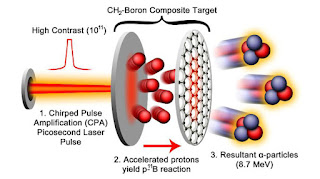NASA engineer proposes new type of fusion thruster for space travel
John J. Chapman, a physicist working for NASA has presented an idea for a new type of fusion thruster for possible use by space traveling vehicles at the IEEE Symposium going on in Chicago this week. In the presentation, as explained on IEEE Spectrum, Chapman suggests that boron be used as an “aneutronic” fuel source, stating that doing so makes the energetic particles easier to deal with than traditional materials.
 |
| Illustration: NASA Langley Research Center |
Chapman’s idea is to use an off-the-shelf laser to shoot at a double-layer target. The first would be comprised of a “thick” sheet of metal foil, which would respond to the laser shots by accelerating the protons. The ensuing out-rush of electrons would leave behind an increased positive charge, which would wind up creating an unbalance between the protons left behind, resulting in a small explosion, which in turn would speed up the protons hurtling towards the second layer, a thin slice of boron-11.
When those protons hit the boron, carbon nuclei would be formed, excited by the impact, which would immediately decay to a helium-4 nucleus and a beryllium nucleus, which would then decay to a pair of alpha particles. This means that each reaction would result in the creation of three alpha particles, which Chapman describes as “very efficient.” Electromagnetic forces would then force the alpha particles and the stuff it hits, in opposite directions, with the alpha particles exiting out a nozzle. The end result would be the craft carrying the fusion thruster, being pushed forward. With the amounts tested, each blip of the laser should theoretically create 100,000 particles, and with some fine tuning, according to Chapman, that would make it far more efficient than current ion propulsion systems. Unfortunately, as great as this all sounds, it doesn’t mean we’ll have spacecraft utilizing such technology any time soon; even if it pans out as Chapman suggests, he says it would still likely be a decade before anything tangible could be produced, and that’s if a concerted effort were made over that time frame by scientists all over the world to figure out how to make it all work as proposed.



















0 comments:
Post a Comment
Please do not spam Spam comments will be deleted immediately upon my review.